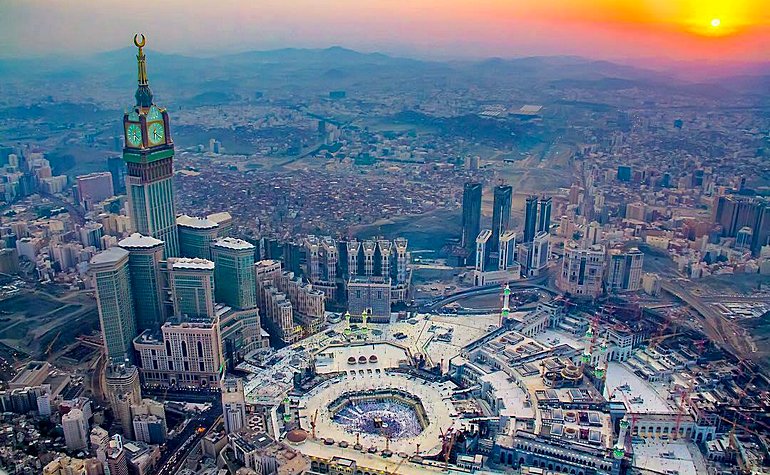The Foundation of Faith
Mecca holds profound religious significance as the birthplace of Islam and the location of its most sacred sites. Situated in the Hejaz region of western Saudi Arabia, the city is central to the faith’s pillars and draws millions of Muslim pilgrims each year to perform the Hajj pilgrimage. At the heart of Mecca lies the Kaaba, a cubical structure located within the expansive courtyards of the Grand Mosque of Mecca, also known as Al-Masjid al-Ḥarām. According to Islamic belief, the Kaaba was originally built by the prophets Abraham and Ishmael, and it is the holiest site for Muslims, who face toward it in prayer five times daily. Pilgrims circumambulate the Kaaba seven times in the ritual of Tawaf as an integral part of Hajj, seeking blessing and spiritual fulfillment.
A Legacy of Faith
Several other sacred sites within the Grand Mosque hold immense religious significance based on their associations with prophets and pivotal events in Islamic history. Maqam Ibrahim marks the spot where Abraham stood while rebuilding the Kaaba, while the Black Stone set in the eastern corner is a precious relic believed sent from heaven. During Tawaf, pilgrims endeavour to kiss or touch these sites in reverence. Nearby, the Hijr Ismail enclosure is considered the burial place of Ishmael’s mother Hagar, connecting pilgrims to Islam’s roots.

Spiritual Journeys Beyond the City
Mecca’s influence extends to landmarks situated outside the city that remain integral to Muslims’ spiritual relationship with their faith. On the plains of Arafat lies Jabal al-Rahmah, where the Prophet Muhammad delivered his final sermon, and pilgrims stand in prayer seeking divine blessings and forgiveness of sins. During Hajj, over two million gather on the hill of mercy on the designated Day of Arafat.
A Valley of Reflection
Nearby Mina valley hosts the central ritual of Hajj where pilgrims ritually stone the three Jamarat pillars, representing their rejection of evil. An essential part of the spiritual journey is spending the night in Muzdalifah between Mina and Arafat, where pilgrims collect pebbles for the stoning before returning to Mina at dawn. These landscape features surrounding Mecca allow followers to fulfill the religious obligations of Hajj while cementing their connection to core Islamic beliefs.
Sustaining Body and Soul
Amid the deeply religious sites, certain landmarks in Mecca play a practical role in sustaining the millions of pilgrims who visit each year. Chief among them is the Zamzam Well located in the Grand Mosque, its water believed to have miraculously sprung forth for Ishmael and possessing healing properties.
Nourishment and Accommodation
Drinking Zamzam water provides both spiritual refreshment and quenches physical thirst. Furthermore, skyscrapers including the Abraj Al-Bait Towers accommodating hundreds of thousands with hotels, restaurants, and prayer areas. The towers’ elegant Islamic architecture and soaring heights allow pilgrims comfortable modern lodging while admiring panoramic views of the sacred locales below. In this way, certain landmarks satisfy practical needs of the masses undertaking the transformative Hajj journey.
Connecting with Mecca’s Heritage
While its religious sites draw millions annually, Mecca also preserves locales significant to Islam’s early history and the city’s cultural heritage. Nestled in the mountains sits Cave Hira, where according to Islamic tradition the Angel Gabriel first appeared to Muhammad and asked him to read - marking the start of Islam’s divine revelations.
Embracing the Past and Future
Pilgrims visit the cave to contemplate Islam’s beginnings and connect to its roots. Additionally, the King Abdulaziz Complex houses invaluable manuscripts, artifacts and an immense library preserving Islamic scholarship and Meccan culture for future generations. These less prominently featured landmarks allow visitors to appreciate Mecca’s rich spiritual legacy while also embracing its role in safeguarding Islamic traditions going forward.
Conclusion
From its most revered holy sites within the Grand Mosque to iconic landscapes facilitating believers’ connection to core rituals and beliefs, Mecca’s numerous landmarks have shaped the Islamic faith since its beginnings. Their religious and historical significance continue drawing millions of pilgrims each year seeking spiritual fulfillment through Hajj or Umrah. Both modern and ancient structures foster Muslims’ relationship with their religion, sustaining souls and culture in the city that first revealed God’s message of peace, justice and compassion.

 A Complete Guide to Visiting Hong Kong from India
A Complete Guide to Visiting Hong Kong from India